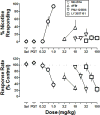Effects of nicotine in combination with drugs described as positive allosteric nicotinic acetylcholine receptor modulators in vitro: discriminative stimulus and hypothermic effects in mice
- PMID: 27238974
- PMCID: PMC4980200
- DOI: 10.1016/j.ejphar.2016.05.032
Effects of nicotine in combination with drugs described as positive allosteric nicotinic acetylcholine receptor modulators in vitro: discriminative stimulus and hypothermic effects in mice
Abstract
Some drugs that are positive allosteric nAChR modulators in vitro, desformylflustrabromine (dFBr), PNU-120596 and LY 2087101, have not been fully characterized in vivo. These drugs were examined for their capacity to share or modify the hypothermic and discriminative stimulus effects of nicotine (1mg/kg s.c.) in male C57Bl/6J mice. Nicotine, dFBr, and PNU-120596 produced significant hypothermia, whereas LY 2087101 (up to 100mg/kg) did not. Nicotine dose-dependently increased nicotine-appropriate responding and decreased response rate; the respective ED50 values were 0.56mg/kg and 0.91mg/kg. The modulators produced no more than 38% nicotine-appropriate responding up to doses that disrupted operant responding. Rank order potency was the same for hypothermia and rate-decreasing effects: nicotine>dFBr>PNU-120596=LY 2087101. Mecamylamine and the α4β2 nAChR antagonist dihydro-β-erythroidine, but not the α7 antagonist methyllycaconitine, antagonized the hypothermic effects of nicotine. In contrast, mecamylamine did not antagonize the hypothermic effects of the modulators. The combined discriminative stimulus effects of DFBr and nicotine were synergistic, whereas the combined hypothermic effects of nicotine with either dFBr or PNU-120596 were infra-additive. PNU-120596 did not modify the nicotine discriminative stimulus, and LY 2087101 did not significantly modify either effect of nicotine. Positive modulation of nicotine at nAChRs by PNU-120596 and LY 2087101 in vitro does not appear to confer enhancement of the nAChR-mediated hypothermic or discriminative stimulus effects of nicotine. However, dFBr appears to be a positive allosteric modulator of some behavioral effects of nicotine at doses of dFBr smaller than the doses producing unwanted effects (e.g. hypothermia) through non-nAChR mechanisms.
Keywords: Additivity; Drug discrimination; Hypothermia; Nicotinic acetylcholine receptor; Positive allosteric modulator; Synergy.
Copyright © 2016 Elsevier B.V. All rights reserved.
Figures







Similar articles
-
The contribution of α4β2 and non-α4β2 nicotinic acetylcholine receptors to the discriminative stimulus effects of nicotine and varenicline in mice.Psychopharmacology (Berl). 2017 Mar;234(5):781-792. doi: 10.1007/s00213-016-4514-4. Epub 2016 Dec 27. Psychopharmacology (Berl). 2017. PMID: 28028600 Free PMC article.
-
Allosteric modulation of α4β2* nicotinic acetylcholine receptors: Desformylflustrabromine potentiates antiallodynic response of nicotine in a mouse model of neuropathic pain.Eur J Pain. 2018 Jan;22(1):84-93. doi: 10.1002/ejp.1092. Epub 2017 Aug 14. Eur J Pain. 2018. PMID: 28809075 Free PMC article.
-
Discriminative stimulus and hypothermic effects of some derivatives of the nAChR agonist epibatidine in mice.Psychopharmacology (Berl). 2014 Dec;231(23):4455-66. doi: 10.1007/s00213-014-3589-z. Epub 2014 May 7. Psychopharmacology (Berl). 2014. PMID: 24800895 Free PMC article.
-
Discriminative Stimulus Properties of S(-)-Nicotine: "A Drug for All Seasons".Curr Top Behav Neurosci. 2018;39:51-94. doi: 10.1007/7854_2017_3. Curr Top Behav Neurosci. 2018. PMID: 28391535 Review.
-
Discriminative stimulus effects of cholinergic agonists and the actions of their antagonists.Psychopharmacol Ser. 1988;4:32-43. doi: 10.1007/978-3-642-73223-2_3. Psychopharmacol Ser. 1988. PMID: 3293044 Review.
Cited by
-
Reversal of Nicotine Withdrawal Signs Through Positive Allosteric Modulation of α4β2 Nicotinic Acetylcholine Receptors in Male Mice.Nicotine Tob Res. 2018 Jun 7;20(7):903-907. doi: 10.1093/ntr/ntx183. Nicotine Tob Res. 2018. PMID: 29059422 Free PMC article.
-
Effect of imidacloprid ingestion on immune responses to porcine reproductive and respiratory syndrome virus.Sci Rep. 2018 Aug 2;8(1):11615. doi: 10.1038/s41598-018-30093-6. Sci Rep. 2018. PMID: 30072754 Free PMC article.
-
Examining the Effects of (α4)3(β2)2 Nicotinic Acetylcholine Receptor-Selective Positive Allosteric Modulator on Acute Thermal Nociception in Rats.Molecules. 2020 Jun 25;25(12):2923. doi: 10.3390/molecules25122923. Molecules. 2020. PMID: 32630476 Free PMC article.
-
Nicotine-like discriminative stimulus effects of acetylcholinesterase inhibitors and a muscarinic receptor agonist in Rhesus monkeys.Drug Dev Ind Pharm. 2019 May;45(5):861-867. doi: 10.1080/03639045.2019.1578787. Epub 2019 Feb 22. Drug Dev Ind Pharm. 2019. PMID: 30712397 Free PMC article.
-
Potentiation of (α4)2(β2)3, but not (α4)3(β2)2, nicotinic acetylcholine receptors reduces nicotine self-administration and withdrawal symptoms.Neuropharmacology. 2021 Jun 1;190:108568. doi: 10.1016/j.neuropharm.2021.108568. Epub 2021 Apr 18. Neuropharmacology. 2021. PMID: 33878302 Free PMC article.
References
-
- Besson M, David V, Suarez S, Cormier A, Cazala P, Changeux JP, Granon S. Genetic dissociation of two behaviors associated with nicotine addiction: Beta-2 containing nicotinic receptors are involved in nicotine reinforcement but not in withdrawal syndrome. Psychopharmacology (Berl) 2006;187:189–199. - PubMed
-
- Broad LM, Zwart R, Pearson KH, Lee M, Wallace L, McPhie GI, Emkey R, Hollinshead SP, Dell CP, Baker SR, Sher E. Identification and pharmacological profile of a new class of selective nicotinic acetylcholine receptor potentiators. J Pharmacol Exp Ther. 2006;318:1108–1117. - PubMed
-
- Buccafusco JJ. Neuronal nicotinic receptor subtypes: Defining therapeutic targets. Mol Interv. 2004;4:285–295. - PubMed
-
- Court J, Martin-Ruiz C, Piggott M, Spurden D, Griffiths M, Perry E. Nicotinic receptor abnormalities in alzheimer’s disease. Biol Psychiatry. 2001;49:175–184. - PubMed
MeSH terms
Substances
Grants and funding
LinkOut - more resources
Full Text Sources
Other Literature Sources
Medical

